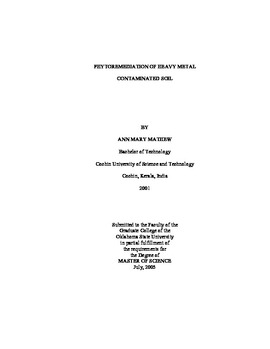| dc.contributor.advisor | Veenstra, John N. | |
| dc.contributor.author | Mathew, Ann Mary | |
| dc.date.accessioned | 2014-04-17T19:56:15Z | |
| dc.date.available | 2014-04-17T19:56:15Z | |
| dc.date.issued | 2005-07-01 | |
| dc.identifier.uri | https://hdl.handle.net/11244/10146 | |
| dc.description.abstract | The purpose of this study was to evaluate the use of phytoremediation in removing heavy metals such as arsenic, cadmium, lead and zinc, from a smelter site located in Oklahoma. Considering the climatic conditions of Oklahoma corn and sunflower were selected for the experiment. Effects of heavy metals on the growth of corn and sunflower and extend of phytoaccumulation were also studied. A concentration ratio was used for determining the better plant for phytoremediation. The study clearly revealed that phytoremediation cannot be used a primary treatment method for the site. The metal concentration in the soil was phytotoxic to sunflower plants. It was found that accumulation of metals was minimal in both the plants. By comparing the the concentration ratio, it was found that corn is better than sunflower for heavy metal uptake. | |
| dc.format | application/pdf | |
| dc.language | en_US | |
| dc.publisher | Oklahoma State University | |
| dc.rights | Copyright is held by the author who has granted the Oklahoma State University Library the non-exclusive right to share this material in its institutional repository. Contact Digital Library Services at lib-dls@okstate.edu or 405-744-9161 for the permission policy on the use, reproduction or distribution of this material. | |
| dc.title | Phytoremediation of Heavy Metal Contaminated Soil | |
| dc.type | text | |
| osu.filename | Mathew_okstate_0664M_1445.pdf | |
| osu.college | Engineering, Architecture, and Technology | |
| osu.accesstype | Open Access | |
| dc.description.department | School of Civil & Environmental Engineering | |
| dc.type.genre | Thesis | |
